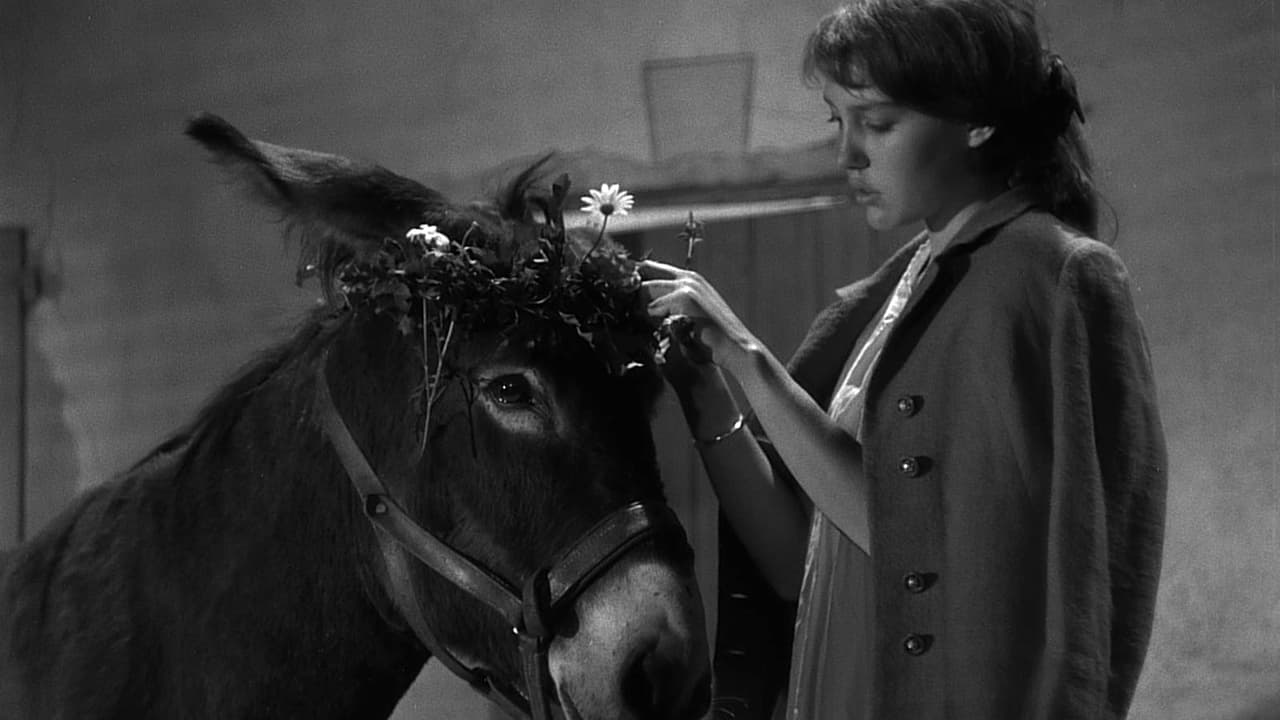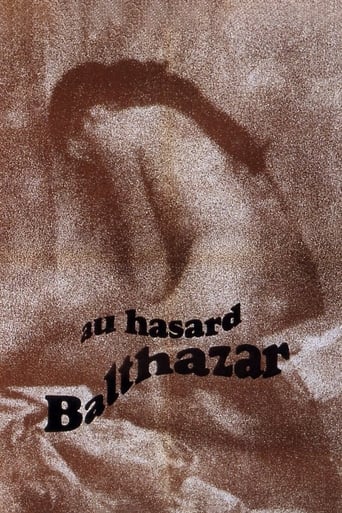

I appreciate all of Bresson's films, but this one stands out ahead of the rest. This is maybe because of how poetic it is, the way the music of Schubert becomes a signature piece for this film and the unforgettable performance by Anne Wiazemsky.Wiazemsky's perfectly captures her character. I heard that this was her first film and it's possible that the difficult experience she had with Bresson, helped her deal with the difficult relationships her character experiences. It is quite apt in today's world, especially with the Hollywood controversy with the treatment of women in cinema. She plays Marie, a coming of age story of a girl who's at first always with her donkey, Balthazar. Her world revolves around him, and it's about the boys who obsess over her and their jealous for the donkey leads to several unwanted events. I don't want to spoil the plot for you, but what I find heroic here is the donkey Balthazar, who seems to be a Christlike figure in the way he endures all sorts of punishment. It's quite a beautiful representation by Bresson, which turns this film into a religious experience.
... View More"You must forgive. Everyone. Much will be forgiven you. You have suffered." One of the most revered filmmakers in the history of cinema, Robert Bresson's acclaimed Au Hasard Balthazar is a film that follows the story of a sensitive farm girl named Marie (Anne Wiazemsky) and her cherished donkey, Balthazar. This would be the sister film of Bresson's next picture Mouchette. Marie and Balthazar are eventually separated when she gets older, the tale follows both the young woman and the donkey as both contend with the hardships of the world. Although Marie and Balthazar often encounter cruelty from various people they encounter, they also discover small moments of beauty. We have seen many times in movies those seeking/finding redemption or offering some sort of sacrifice for a cause far greater than themselves. But what if these actions were performed through the titular farmyard animal lead? Does it work? Let's take a look.We first see Balthazar as a newborn as he takes his first unsteady steps. This is a slight metaphor for the rest of the film. Three children sprinkle water on its head and baptize it. Unbeknownst to the little colt, he will be owned by many of the locals and be returned to some of them more than once, some kind, others cruel. Balthazar's first owner is Marie, of whom lives with her parents; her mother (Nathalie Joyaut) and father (Philippe Asselin, the local schoolmaster). Her playmate is Jacques (Walter Green), of whom agrees will marry the girl someday. When Jacque's mother dies, his grief-stricken father leaves the district, entrusting his farm to Marie's father, in whom he has complete trust. Marie has an immediate connection with Balthazar, happily decorating his bridle with wild flowers. However she does nothing to protect the animal when a local gang of boys torment the him. The leader is Gerard (François Lafarge), the son of the local baker.As the years pass, Marie grows up and the pair become separated. We see, though, how the film traces both of their fates as they both embark on parallel sojourns, continually taking abuse of all forms from the people they come across. Balthazar has several owners, as most exploit him, some times more with brutality than love. Both even suffer at the hands of the same people. How can one not feel for the beloved beast of burden with the white-spotted face, long fuzzy ears and big black eyes? We empathize his sense of the cold when we see the snow on his fur; his sense of pain and alarm when his tail is set ablaze for refusing to move; his satisfaction and contentment when he eats; his ridicule when trained to count math equations at a circus; the worn look in his eyes and weary feeling in his legs when overworked with heavy loads by ruthless masters. We unfortunately see Gerard again when his father purchases the burro to carry bread. The boy tortures the donkey as he tries in another scene to get close to Marie. In the end, Marie's fate remains unresolved whereas the donkey's is clear. Balthazar, now older and worn, one day aimlessly wanders into an open field. A herd of sheep surround him as he lays down, braying as a final sacrament before he passess on.Bresson said that he wanted to make a different style of filmmaking using his theory of "pure cinema" after making several prison-themed films. Balthazar was inspired by Fyodor Dostoyevsky's The Idiot, as each episode in Balthazar's life represents one of the seven deadly sins. The film was "made up of many lines that intersect one another", Bresson later stated, and that Balthazar was meant to be a symbol of the Christian faith. Bresson was known for casting unknown actors, which gave his films more layers of depth and humanity on a level many other filmmakers rarely capture. Wiazemsky's 2007 book Jeune Filleon tells of her experiences during filming Balthazar, regarding how she and Bresson developed a close relationship during shooting, although it was not consummated, and how she lost her virginity to a member of the film's crew. Critics and film reviewers widely praised Balthazar, including the noted filmmaker of the French New Wave and Cahiers du Cinema critic Jean- Luc Godard, of whom eventually went on to marry Wiazemsky. Imbued with religious imagery, spiritual allegories, shot with a naturalistic, minimalist aesthetic style and a study on saintliness, Balthazar contains a powerful spiritual message that is both revolutionary as it is rewarding.
... View MoreDirector Robert Bresson amazes here by coaxing an extremely moving performance from a donkey named Balthazar. By comparison, the humans around him appear stubborn, shallow, cruel, and mercenary. We gain a troubling picture here of the indifference of nature, and the ultimate aloneness of the innocent. The final scene of this film is heartbreaking! Running counterpoint to Balthazar's story are the complicated comings and goings of various humans, none of whom is very likable. We focus on the dour Marie (Anne Wiazemsky), who rebels against her sheltered lifestyle by sleeping with a sinister young hood (Walter Green) and sells her body when necessary. We also follow, for reasons that aren't terribly clear, the peregrinations of an unappealing bum named Arnold (Jean-Claude Guilbert). Now that I have seen this intriguing film, along with "Diary of a Country Priest," I'm interested in viewing anything else that Bresson has directed. What a unique perspective he brings!
... View MoreAmong many possible objections to this overvalued movie; -As usual in Bresson movies, acting is awful and I can not understand how people (mostly movie critics) overlook or tolerate such a shortcoming in any movie of considerable value - "Unpunished crime" is used in many Hollywood movies to emotionally involve the audience. In this movie, injustice against both the heroine and the donkey is utilized to agitate the audience. Criterion version includes an interview with a "Bresson Critic" who confesses that the first question that he asked the leading actress was "What happened to ..."(the bad guy) which demonstrates his emotional involvement with the plot; "Is he punished for his deed?". This is a very cheap way to attract viewer's attention. - Rhythm (as in other Bresson movies) is very monotonous. It helps in the prison escape movie "A Man Escaped" because escape effort as depicted requires meticulous monotonous effort, But only there.... -Final dramatic scene and circus scene where animals seem to communicate somehow are highlights of the movie. -It attracted my attention that many "vague" directors (including Godard) have tiny nose. It is often said that creativity is associated with bigger nose :) I have seen several convincing proofs.
... View More